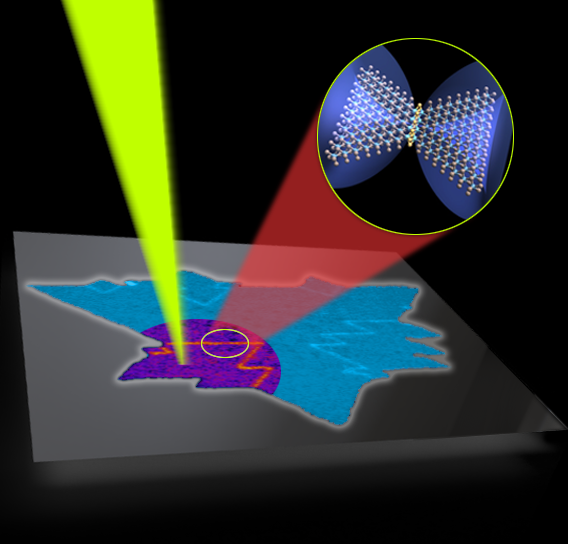Jan 28 2020
The semiconductor industry exhibits interest in employing 2D materials to further decrease the size of electronic devices and to reduce energy consumption. However, manufacturers look for a fast and precise technique to detect defects in these materials to find whether the material is appropriate for manufacturing devices.
 A laser beam (yellow) reflects off a 2D material (orange), highlighting a grain boundary defect in the atomic lattice. Image Credit: MRI/Penn State.
A laser beam (yellow) reflects off a 2D material (orange), highlighting a grain boundary defect in the atomic lattice. Image Credit: MRI/Penn State.
At present, a research team has devised a method for fast and sensitive characterization of defects in 2D materials, which are atomically thin. One of the most familiar 2D materials is graphene, which is a single-atom-thick layer of carbon atoms.
People have struggled to make these 2D materials without defects. That’s the ultimate goal. We want to have a 2D material on a four-inch wafer with at least an acceptable number of defects, but you want to evaluate it in a quick way.
Mauricio Terrones, Verne M. Willaman Professor of Physics, Penn State
The solution put forward by the team—including researchers from Penn State, Northeastern University, Rice University, and Universidade Federal de Minas Gerais in Brazil—is to use laser light in combination with second harmonic generation, a phenomenon where the frequency of light shone on the material is reflected at twice the original frequency.
The team added dark field imaging, a method that involves filtering out extraneous light so that defects shine through. The researchers said this is the first-ever time dark-field imaging has been used, and that it offers three times the brightness of the typical bright field imaging technique. This feature enables observing types of defects that were earlier not invisible.
The localization and identification of defects with the commonly used bright field second harmonic generation is limited because of interference effects between different grains of 2D materials.
Leandro Mallard, Professor, Universidade Federal de Minas Gerais
“In this work we have shown that by the use of dark field SHG we remove the interference effects and reveal the grain boundaries and edges of semiconducting 2D materials. Such a novel technique has good spatial resolution and can image large area samples that could be used to monitor the quality of the material produced in industrial scales,” added Mallard, who is also a senior author on a recent paper published in Nano Letters.
Vincent H. Crespi, Distinguished Professor of Physics, Materials Science and Engineering, and Chemistry, Penn State, added, “Crystals are made of atoms, and so the defects within crystals—where atoms are misplaced—are also of atomic size.”
Usually, powerful, expensive and slow experimental probes that do microscopy using beams of electrons are needed to discern such fine details in a material. Here, we use a fast and accessible optical method that pulls out just the signal that originates from the defect itself to rapidly and reliably find out how 2D materials are stitched together out of grains oriented in different ways.
Vincent H. Crespi, Distinguished Professor of Physics, Materials Science and Engineering, and Chemistry, Penn State
Another co-author of the study compared the method to the identification of a specific zero on a page full of zeroes.
“In the dark field, all the zeroes are made invisible so that only the defective zero stands out,” stated Yuanxi Wang, assistant research professor at Penn State’s Materials Research Institute.
According to Terrones, the semiconductor industry intends to be able to check for defects on the production line, but the use of 2D materials in sensors will possibly be made before their use in electronics. Since 2D materials are flexible and can be added even into extremely small spaces, they can be ideally used for multiple sensors in a smartphone or smartwatch, and in various other places where tiny, flexible sensors are needed.
“The next step would be an improvement of the experimental setup to map zero dimension defects—atomic vacancies for instance—and also extend it to other 2D materials that host different electronic and structural properties,” stated Bruno Carvalho, lead author of the study, who is a former visiting scholar in Terrones’ group.
Kuzanori Fujisawa, Tianyi Zhang, Ethan Kahn, Ismail Bilgin, Pulickel Ajayan, Ana de Paula, Marcos Pimenta, and Swastik Kar are the other co-authors on the Nano Letters paper, titled “Nonlinear Dark-Field Imaging of One-Dimensional Defects in Monolayer Dichalcogenides.”
This study was financially supported by the National Science Foundation, the Air Force Office of Scientific Research, and several Brazilian funding agencies.